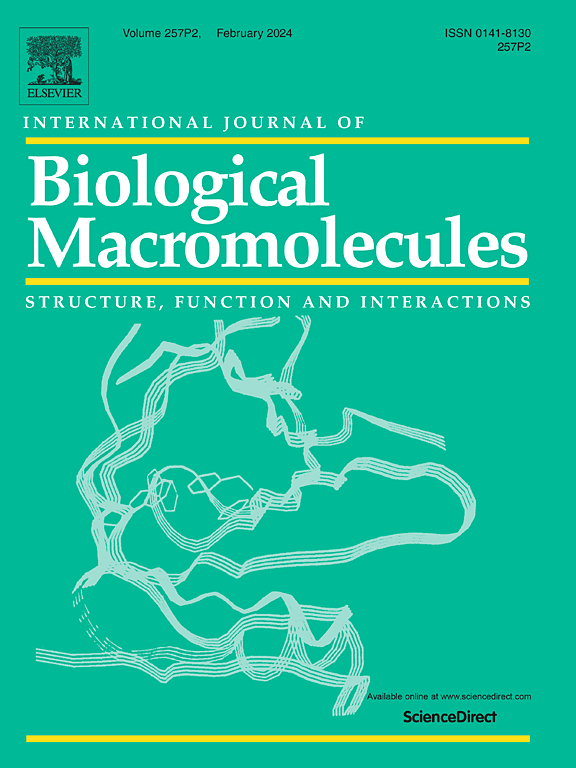枣椰心多糖的结构表征和功能评价:α-淀粉酶抑制和降糖潜力的研究
IF 8.5
1区 化学
Q1 BIOCHEMISTRY & MOLECULAR BIOLOGY
International Journal of Biological Macromolecules
Pub Date : 2025-06-20
DOI:10.1016/j.ijbiomac.2025.145425
引用次数: 0
摘要
植物源性多糖因其多种生物活性特性而越来越受到关注,特别是在糖尿病等代谢紊乱的治疗中。本研究旨在分离、表征和评价一种新型多糖从枣棕榈(Phoenix dactylifera L.)的心脏,命名为PHDP,其潜在的抗糖尿病活性。采用比色法、傅里叶变换红外光谱法(FTIR)、核磁共振法(NMR)、气相色谱-质谱联用法(GC-MS)和粒径排除色谱法(SEC)对其进行了全面的结构表征,提取回收率为43%。单糖组成分析显示葡萄糖(41.3%)、甘露糖(38.8%)、半乳糖(14.9%)、阿拉伯糖(2.6%)和鼠李糖(2.3%),以及27.1%的醛酸,表明半乳糖葡聚糖(GMG)的弱酯化果胶多糖结构特征。SEC的构象分析证实了随机线圈结构。体外α-淀粉酶抑制实验显示了一种混合型抑制机制,证明了PHDP调节碳水化合物代谢的能力。此外,四氧嘧啶诱导的糖尿病大鼠体内实验显示,四氧嘧啶具有显著的降糖作用,改善了血脂,调节了关键的血浆酶,从而证实了其抗氧化和降糖活性。这些发现强调了PHDP作为一种可行的天然药物来开发安全的、基于植物的抗糖尿病治疗方法。本文章由计算机程序翻译,如有差异,请以英文原文为准。

Structural characterization and functional evaluation of polysaccharides extracted from the heart of date palm (Phoenix dactylifera L.): Insights into α-amylase inhibition and antidiabetic potential
Plant-derived polysaccharides are gaining increasing attention for their diverse bioactive properties, particularly in the management of metabolic disorders such as diabetes. This study aims to isolate, characterize, and evaluate a novel polysaccharide from the heart of the date palm (Phoenix dactylifera L.), designated PHDP, for its potential antidiabetic activity. The extraction process yielded a recovery rate of 43 %, with comprehensive structural characterization performed using colorimetric assays, Fourier transform infrared spectroscopy (FTIR), nuclear magnetic resonance (NMR), gas chromatography coupled with mass spectrometry (GC–MS), and size exclusion chromatography (SEC). Monosaccharide composition analysis revealed the presence of glucose (41.3 %), mannose (38.8 %), galactose (14.9 %), arabinose (2.6 %), and rhamnose (2.3 %), along with 27.1 % uronic acids, indicative of a weakly esterified pectic polysaccharide structure characteristic of galactomannoglucan (GMG). Conformational analysis by SEC confirmed a random coil architecture. In vitro α-amylase inhibition assays revealed a mixed-type inhibition mechanism, demonstrating PHDP's ability to modulate carbohydrate metabolism. Furthermore, in vivo experiments using alloxan-induced diabetic rats showed significant hypoglycemic effects, improved lipid profiles, and regulation of key plasma enzymes, thereby confirming its antioxidant and antidiabetic activities. These findings highlight PHDP as a viable natural agent for developing safe, plant-based antidiabetic treatments.
求助全文
通过发布文献求助,成功后即可免费获取论文全文。
去求助
来源期刊
CiteScore
13.70
自引率
9.80%
发文量
2728
审稿时长
64 days
期刊介绍:
The International Journal of Biological Macromolecules is a well-established international journal dedicated to research on the chemical and biological aspects of natural macromolecules. Focusing on proteins, macromolecular carbohydrates, glycoproteins, proteoglycans, lignins, biological poly-acids, and nucleic acids, the journal presents the latest findings in molecular structure, properties, biological activities, interactions, modifications, and functional properties. Papers must offer new and novel insights, encompassing related model systems, structural conformational studies, theoretical developments, and analytical techniques. Each paper is required to primarily focus on at least one named biological macromolecule, reflected in the title, abstract, and text.

 求助内容:
求助内容: 应助结果提醒方式:
应助结果提醒方式:


